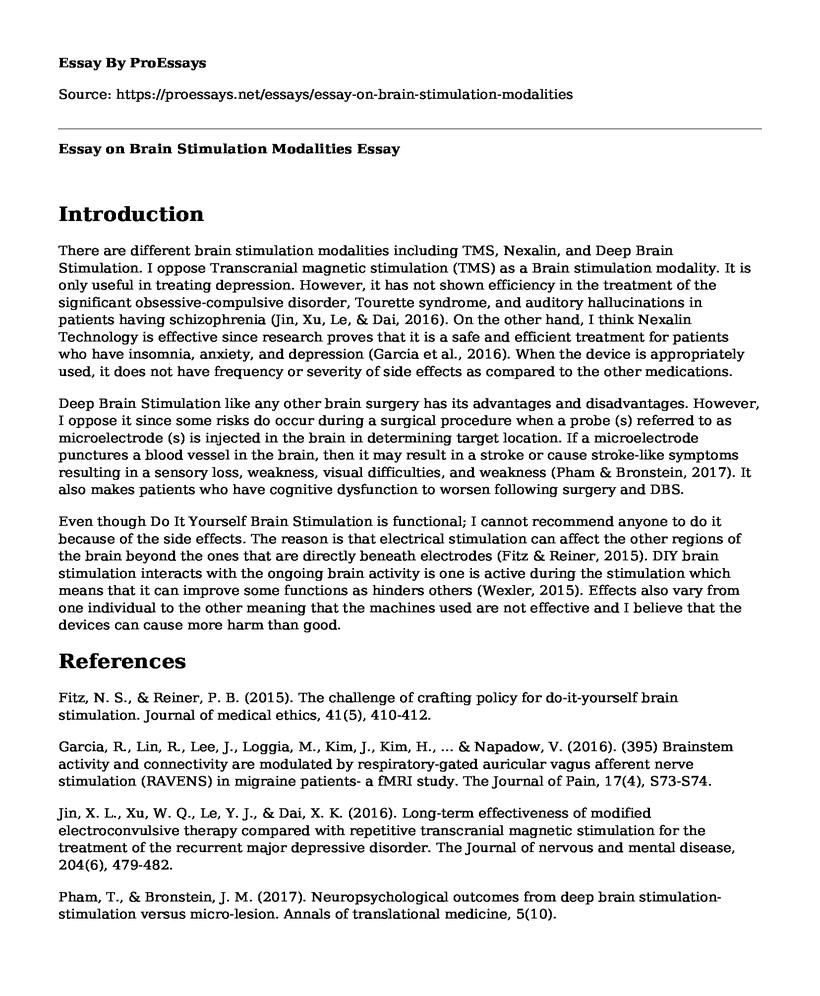Introduction
There are different brain stimulation modalities including TMS, Nexalin, and Deep Brain Stimulation. I oppose Transcranial magnetic stimulation (TMS) as a Brain stimulation modality. It is only useful in treating depression. However, it has not shown efficiency in the treatment of the significant obsessive-compulsive disorder, Tourette syndrome, and auditory hallucinations in patients having schizophrenia (Jin, Xu, Le, & Dai, 2016). On the other hand, I think Nexalin Technology is effective since research proves that it is a safe and efficient treatment for patients who have insomnia, anxiety, and depression (Garcia et al., 2016). When the device is appropriately used, it does not have frequency or severity of side effects as compared to the other medications.
Deep Brain Stimulation like any other brain surgery has its advantages and disadvantages. However, I oppose it since some risks do occur during a surgical procedure when a probe (s) referred to as microelectrode (s) is injected in the brain in determining target location. If a microelectrode punctures a blood vessel in the brain, then it may result in a stroke or cause stroke-like symptoms resulting in a sensory loss, weakness, visual difficulties, and weakness (Pham & Bronstein, 2017). It also makes patients who have cognitive dysfunction to worsen following surgery and DBS.
Even though Do It Yourself Brain Stimulation is functional; I cannot recommend anyone to do it because of the side effects. The reason is that electrical stimulation can affect the other regions of the brain beyond the ones that are directly beneath electrodes (Fitz & Reiner, 2015). DIY brain stimulation interacts with the ongoing brain activity is one is active during the stimulation which means that it can improve some functions as hinders others (Wexler, 2015). Effects also vary from one individual to the other meaning that the machines used are not effective and I believe that the devices can cause more harm than good.
References
Fitz, N. S., & Reiner, P. B. (2015). The challenge of crafting policy for do-it-yourself brain stimulation. Journal of medical ethics, 41(5), 410-412.
Garcia, R., Lin, R., Lee, J., Loggia, M., Kim, J., Kim, H., ... & Napadow, V. (2016). (395) Brainstem activity and connectivity are modulated by respiratory-gated auricular vagus afferent nerve stimulation (RAVENS) in migraine patients- a fMRI study. The Journal of Pain, 17(4), S73-S74.
Jin, X. L., Xu, W. Q., Le, Y. J., & Dai, X. K. (2016). Long-term effectiveness of modified electroconvulsive therapy compared with repetitive transcranial magnetic stimulation for the treatment of the recurrent major depressive disorder. The Journal of nervous and mental disease, 204(6), 479-482.
Pham, T., & Bronstein, J. M. (2017). Neuropsychological outcomes from deep brain stimulation-stimulation versus micro-lesion. Annals of translational medicine, 5(10).
Wexler, A. (2015). The practices of do-it-yourself brain stimulation: implications for ethical considerations and regulatory proposals. Journal of Medical Ethics, metaethics-2015.
Cite this page
Essay on Brain Stimulation Modalities. (2022, Jul 25). Retrieved from https://proessays.net/essays/essay-on-brain-stimulation-modalities
If you are the original author of this essay and no longer wish to have it published on the ProEssays website, please click below to request its removal:
- Hand Hygiene among Health Care Workers on Labor and Delivery Unit - Essay Sample
- The Issue of Vaccination Annotated Bibliography
- Social Workers: Rules, Strategies & Challenges for Social Welfare - Essay Sample
- COVID-19: Adapting to a New Normal With Digital Tools - Essay Sample
- Essay Example on Bottled vs Tap Water: Benefits and Drawbacks
- Essay Example on Assisted Living: 4M+ Patients Annually Seek Care for Memory Disorders
- Essay Example on Genetically Modified Foods: Benefits for Global Food Security







